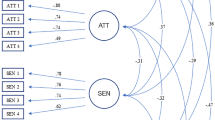Abstract
In this longitudinal study adjustment to kindergarten during the first year was examined as a function of individual temperament characteristics and other social and demographic factors in 127 girls and 133 boys. Adjustment was measured using a scale developed by Thompson. Temperament was assessed using the Parent Temperament Questionnaire. In all, 13.3% of the sample were judged by teachers to be experiencing some or considerable difficulty adjusting to kindergarten in term 1 and 5.7% were experiencing problems in term 3. Children of “difficult” temperament were perceived by teachers to be significantly more poorly adjusted than children of “easy” temperament in term 1 but not term 3. Results indicated that the temperament characteristic of low adaptability was most closely linked to poor kindergarten adjustment. However, temperament and various social and demographic factors only accounted for a small amount of variance. The findings were discussed in relation to the need to further understand the nature of factors contributing to kindergarten adjustment and to understanding why some children's adjustment problems persist throughout the first year.
Similar content being viewed by others
References
Thompson B: Adjustment to school.Educational Research 17:128–136, 1975.
Thomas A, Chess S:Temperament and Development. New York, Brunner/Mazel, 1977.
Hughes M, Pinkerton G, Plewis I: Children's difficulties on starting infant school.Journal of Child Psychology and Psychiatry 20:187–196, 1979.
Dohrenwend BP, Dohrenwend BS, Gould M, Link B, Neugebauer R, Wunschhitzig R:Medical Illness in the United States: Epidemological Estimates. New York, Praeger, 1980.
Chazan M, Jackson S: Behaviour problems in the infant school: changes over two years.Journal of Child Psychology and Psychiatry 18:201–209, 1974.
Carey WB, Fox M, McDevitt SC: Temperament as a factor in early school adjustment.Paediatrics 60:621–624, 1977.
Klein HA: The relationship between children's temperament and adjustment to kindergarten and head start settings.The Journal of Psychology 112:259–268, 1982.
Cox T: Children's adjustment to school over six years.Journal of Child Psychology and Psychiatry 19:363–371, 1978.
Davie R: Butler N. and Goldstein, H.,From Birth to Seven, London, Longman, 1970.
Congalton AA:Status and Prestige in Australia, Sydney, Cheshire, 1969.
Dunn J, Kendrick C: Studying temperament parent-child interaction: comparison of interview and direct observation.Developmental Medicine and Child Neurology 4:484–496, 1980.
Carey WB: A simplified method for measuring infant temperament.Journal of Pediatrics 77:188–194, 1970.
Slee PT: Children's adjustment to kindergarten.Australian Journal of Early Childhood In press, 1986.
Barron, AP, Earls F: The relation of temperament and social factors to behaviour problems in three-year-old children.Journal of Child Psychology and Psychiatry 25:22–33, 1984.
Berscheid E, Walster E: Physical attractiveness. In Berkowitz (Ed.)Advances in Experimental Social Psychology, pp. 157–214. New York, Academic Press, 1974.
Sorell GT, Nowak CA: The role of physical attractiveness as a contributor to individual development. In Lerner RM, Busch-Rossnagel NA (Eds.)Individuals as Producers of Their Development. A Life-Span Perspective, pp. 389–446. New York, Academic Press, 1981.
Lerner JV, Lerner RM, Zabski S: Temperament and children's actual and rated academic performance: A test of a “goodness-of-fit” model.Journal of Child Psychology and Psychiatry 26(1):125–136, 1985.
Author information
Authors and Affiliations
Additional information
I should like to acknowledge the invaluable assistance of Ms. Diane Lawson in this study. The assistance of Dr. M. O'Neil of the Kindergarten Union of South Australia is gratefully acknowledged as is the co-operation of the teachers and parents involved in the study. This work was supported by a grant from the South Australian Institute of Technology (No. 276).
Rights and permissions
About this article
Cite this article
Slee, P.T. The relation of temperament and other factors to children's kindergarten adjustment. Child Psych Hum Dev 17, 104–112 (1986). https://doi.org/10.1007/BF00706649
Received:
Accepted:
Issue Date:
DOI: https://doi.org/10.1007/BF00706649




